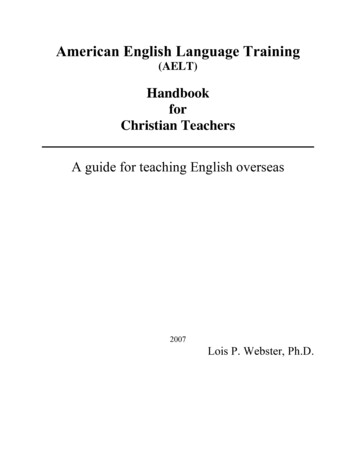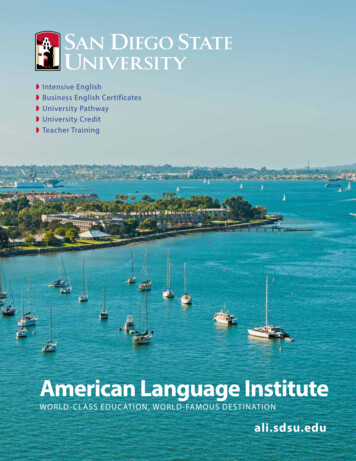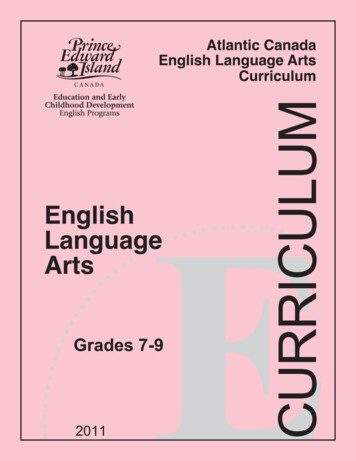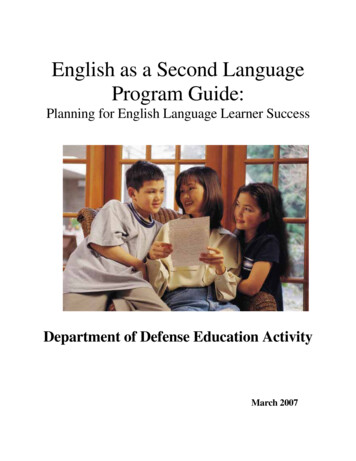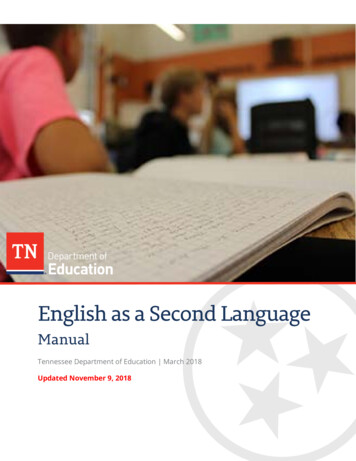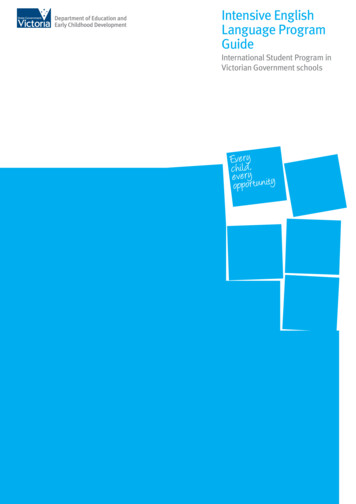
Transcription
Intensive EnglishLanguage ProgramGuideInternational Student Program inVictorian Government schools1Intensive English Language Program
Intensive English Language Program2
ContentsIntroduction5Part 1: Overview7Section 1: Context8Section 2: ESL learning pathway11Section 3: Integrating international students intothe school14Part 2: Establishing an IELP23Section 1: Introduction24Section 2: Preliminary planning for an IELP25Section 3: Organizational Structures for the IELP32Part 3: Meeting the IELP Guidelines35Guideline 1: Physical Facilities39Guideline 2: Staffing41Guideline 3: Orientation49Guideline 4: Program provision and schoollevel reporting56Guideline 5: Assessment86Guideline 6: Liaison with the host school and/orthe mainstream program102Guideline 7: Student care and welfare arrangements 112Guideline 8: Record keeping120 Intensive English Language Program(IELP) Guidelines123Part 4: Beyond the IELP: ESL support forinternational students137Section 1: Introduction138Section 2: Planning ESL Support139Section 3: Program advice Year 10 programs144Section 4: Senior Secondary153Part 5: Support materials157Introduction160Section 1: Whole School Planning161Section 2: Teaching and Learning193Section 3: Resources294Acronyms3308Intensive English Language Program
Intensive English Language Program4
IntroductionThe Intensive English Language Program (IELP) Guide has beendeveloped by the International Education Division (IED), to supportVictorian Government schools participating in the InternationalStudent Program in Victoria.Reference to the “Department” means the Department ofEducation and Early Childhood Development (DEECD) and includesany Department which may succeed to the functions of thatDepartment.The main purpose of the IELP Guide (the Guide) is to: assist schools to establish and deliver high quality IELPs forinternational students expand on and support the IELP Guidelines which sitbeside, and are consistent with, the International StudentProgram Quality Standards for Schools assist schools in providing on-going ESL support forinternational students provide practical advice to specialist ESL and mainstreamteachers on program planning and implementation provide resource documents that can be used or adapted byschools at a whole school or IELP level to enhance provisionfor international students.The IELP Guide, Guidelines and all other International StudentProgram resources are available to download online at:www.education.vic.gov.auFurther information regarding the IELP Guide is available from:International Education DivisionDepartment of Education and Early Childhood DevelopmentGPO Box 4367, Melbourne Victoria 3001Tel 9637 2990 / Fax 9637 2184CRICOS Provider Code: 00861KThe IELP Guide is published by the International EducationDivision, Department of Education and Early ChildhoodDevelopment.Schools are free to copy this publication within constraints of theCopyright Act 1968 and for the purposes of educating their ownstaff about the Intensive English Language Program / InternationalStudent Program within Victorian Government schools. State Government of Victoria 20105Intensive English Language Program
Intensive English Language Program6
Part 1:Overview7Intensive English Language Program
Section 1: ContextThe International Student Program inVictorian Government schoolsSince the introduction of international students into VictorianGovernment schools in 1994, the number of students seekingplaces has grown steadily each year.In 2010 in excess of 3700 international students from 75 countrieswere enrolled in 380 Victorian Government schools, with themajority in Years 10, 11 and 12. The main countries of origin areChina, Vietnam and Korea.The previous educational experiences and the level of English varyconsiderably within this cohort, as will factors such as motivation,application and aptitude. As for any group of students, IntensiveEnglish Language Programs (IELPs) will need to take into accountthe particular needs of international students and plan and deliverhigh quality programs accordingly.English language requirementsThe International Education Division (IED) School Resource Kitstates:All secondary international students are required toundertake a standard 20 week IELP prior to their scheduledcommencement of their principal course. Students will berequired to enrol in a 20-week (2 terms) English Languagecourse prior to scheduled commencement of their principalcourse unless the student has fulfilled: All school instruction using English as the main language Instructed in English in an international school for aminimum of the past two years Achieved an IELTS test score of 5.0 or equivalent Undertaken a private English language program for aminimum of 20 consecutive weeks prior to scheduled VGSprogram commencement.Applicants from China are required by DIAC to have anapproved English language test score, such as an IELTS score,to enter a high school program unless they are issued with anIELTS Waiver letter from an accredited education agent or fromthe Division.Refer to the School Resource Kit – Chapter 4, page 8.Part 1: Overview8
IELP GuidelinesGuidelines have been developed for each of the key components ofa successful IELP. They cover the following areas: Physical facilities Staffing Orientation Program provision and school level reporting Assessment Liaison with the host school and mainstream program Student care and welfare arrangements Record keepingOutcome statements and performance indicators have beendeveloped for each guideline along with suggested resourcesand notes.Purpose of the IELP GuideThe main purpose of the IELP Guide (the Guide) is to: assist schools to establish and deliver high quality IntensiveEnglish Language Programs for international students expand on and support the IELP Guidelines which sitbeside, and are consistent with, the International StudentProgram Quality Standards for Schools assist schools in providing on-going ESL support forinternational students provide practical advice to specialist ESL and mainstreamteachers on program planning and implementation provide resource documents that can be used or adapted byschools at a whole school or IELP level to enhance provisionfor international students.Using the GuideThe Guide has five main parts:Part 1: IntroductionPart 2: Establishing an IELPPart 3: Meeting the IELP GuidelinesPart 4: Beyond the IELP: ESL support for international studentsPart 5: Support materialsSchools can use all or parts of the Guide depending upon theirlevel of experience and expertise with international students andwhether they are in the establishment or maintenance phase of9Intensive English Language Program
program planning and delivery. For example, schools consideringestablishing a program will find that Part 2 contains useful adviceon checking the readiness of their schools for an IELP.The Guide focuses in particular on the preparation of internationalstudents for the senior years of schooling. However, many ofthe approaches to course planning and teaching strategies areapplicable to other year levels of schooling and to all ESL students.Some of the material is intended for schools with full timeintensive programs, other sections will be of use to classroomteachers with one or two international students in their class.Support materialsPart 5 provides a range of support materials designed to providepractical assistance to schools. All resources have been developedin Word to allow for adaptation by schools. Some materials inParts 1-4 of the Guide have been included in Part 5 to make it moreaccessible for use as handouts.Please note:The Guide draws heavily on a number of previously published andunpublished documents, in developed by DEECD and teachers maytherefore be familiar with some of the material. These include: ESL Course Advice S1 and S2 (curriculum@work CD ROM) ESL Course Advice S3 and S4 (curriculum@work CD ROM)The ESL Handbook Advice to schools on programs for supportingstudents learning English as a second language (Department ofEducation (Vic) 2007. chlearn/student/eslhandbook.pdfThe Guide should be read in conjunction with relevant chaptersof the School Resource Kit. perations/international/Teachers can also access support material developed for local ESLstudents. For further information see: ograms/esl/default.htmPart 1: Overview10
Section 2: ESL learning pathwayTheoretical perspectives on secondlanguage learning underpinning provisionESL Stages and pathwaysPlanning and provision for all ESL learners takes place withinthe context of the second language learning pathway. Anunderstanding of the broad stages second language learners gothrough, and the research on length of time and other factorsinfluencing rate of second language acquisition, is critical to goodplanning and provision.The ESL Companion to the Victorian Essential Learning Standards(VELS) outlines the broad stages of ESL language developmentfor primary and secondary students and prescribes a set ofstandards for ESL learners in Victoria. The ESL DevelopmentalContinuum P–10 provides evidence based indicators of progresson a continuum that highlight critical understandings required bystudents in order to progress through the standards. Key factorsaffecting the rate at which students progress through the stagesare age and the amount and type of ESL support students receive.The literature on second language acquisition often refers to twodifferent types of English, Basic Interpersonal Communication(BICS) and Cognitive Academic Language Proficiency (CALP)(Cummins). In higher year levels the CALP English languagedemands of the mainstream curriculum become increasinglycomplex. Therefore, during the early stages of ESL learning,younger students are likely to manage the English demands ofmainstream primary classes sooner than older students. Thisconcept is reflected in the number of stages provided in the ESLCompanion to the VELS for the different bands of schooling. The“rainbow diagram” (refer to the ESL Companion to the VELS)reflects, in broad terms, the stages students at different levels willprogress through.When students move between different learning settings, such asbetween intensive ESL programs and schools, or from ESL classesto mainstream classes, their level of English language proficiencymay appear to change as the degree of task difficulty increases andcontextual support decreases. The demands of different programsor settings and the effect these may have on apparent proficiencyneed to be taken into account when the language learning of ESLstudents is being assessed.11Intensive English Language Program
Factors affecting learners’ acquisition ofEnglish as a Second LanguageA range of factors affects the rate at which second languagelearners reach parity with native speaking peers. Age, previousschooling experience and level of literacy in first language aresignificant. Research puts the optimum age for learning a secondlanguage as between 8–11 years if learners have age-equivalenteducation. A study by Collier (1987) confirmed that “the fastestattainment of the second language for academic purposes occursamong those whose age on arrival is 8–11 years” (Collier, V. TESOLQuarterly Vol 21 No 4 December 1987)It also confirmed that ‘the most significant student backgroundvariable is the amount of formal schooling students have receivedin their first language’.Of all the student background variables, the most powerfulpredictor of academic success in L2 is formal schooling in L1.This is true whether L1 schooling is received only in homecountry or in both home country and the US (p. 39)Other factors which will affect learners’ acquisition of Englishinclude: previous experience with English cultural knowledge cognitive ability motivation attitude to the host culture social, emotional and physical health school attendance experience with the culture of school and ways of teachingand learning engagement with other learners in classroom and school socio-economic status of family and community support from family and the community expertise of teachers and program quality the amount of targeted ESL support students receive school support.Part 1: Overview12
What does the research tell us about successfulprogram characteristics for secondary ESL learners?The Collier and Thomas research found that the programcharacteristics that can make a significant difference in academicachievement for English language learners at the secondary levelinclude: second language taught through academic content; conscious focus on teaching learning strategies needed todevelop thinking skills and problem-solving abilities; and continuous support for staff development emphasizingactivation of students’ prior knowledge, respect forstudents’ home language and culture, cooperative learning,interactive and discovery learning, intense and meaningfulcognitive/academic development, and ongoing assessmentusing multiple measures (Collier 1995).Implications of ESL pathways for forms of school supportAll international students, even those who have been assessed atIELTS level 5, or as established at S 4 stage on the ESL Companionto the VELS, will need ESL support. The table below sets out thekinds of ESL support schools need to provide for ESL learners atdifferent stages of their ESL learning.For those students with very limited English at time of arrival, a fulltime intensive course is necessary to provide a sound foundationfor continued English language learning.As time is limited for international students enrolling in the lateryears of secondary schooling to become proficient in English, thereneeds to be continued and targeted ESL support.Type of program by stage of ESL learningBeginner (S1-S2):Intensive program(minimum 20 hours pw)Intermediate (S2-3)Intensive ESL SupportAdvanced (S4)ESL Support ESL informedmainstream teaching13Intensive English Language Program
Section 3: Integratinginternational students intothe schoolUnderstanding the needs of international students andestablishing good practices to help them settle into their newlearning environment is essential whether students are attendingan IELP or going directly into mainstream classes. This sectionsuggests some ways in which international students can beintegrated into the whole school program.Part 5 of the Guide contains ideas and materials to supportthe integration of international students into their new schoolcommunity.Understanding international studentsInternational students have much in common with other studentsattempting the later years of schooling in a Victorian Governmentschool, but there are some key factors which need to beacknowledged if international students are to be well supported intheir learning.These include: International students have made a conscious decision toundertake their final years of education in a foreign country They do not have many of the common experiencesassociated with living and learning in Australia nor do theyhave a ready understanding of the Australian schoolingsystem and teaching approaches Many will not be proficient in English, and will therefore belearning English while being instructed in English They may experience frustration due to the gap betweentheir level of knowledge and their capacity to show thisin English. It may also hamper their capacity to formfriendships.They do however bring an understanding of life and schoolingin another culture, and will be proficient in at least one otherlanguage.Part 1: Overview14
International Student NeedsNeeds shared by most international students include the following:The need to learn English for social and academicpurposes in a very short time frameUnderstanding the enormity of the task faced by most internationalstudents is critical to ensuring that all opportunities to learn andpractice English in formal and informal situations are taken.The need to “pick up” aspects of the Australianculture and vernacular in order to access much of themainstream curriculumBecoming familiar with the many aspects of Australian society,history and culture embedded in the curriculum that local studentsare assumed to know can be a challenge for international students.The need for supported opportunities to demonstratelearningThere may be a gap between the knowledge international studentshave of the content being taught, and their capacity to expressthis is English. This can lead to frustration and disappointmentparticularly at assessment time. Teachers need to provide everyopportunity and means for international students to indicate whatthey do know about a topic, while supporting their continuedlearning of English.The need for explicit information about teaching andlearning in AustraliaInternational students will bring with them a range ofunderstandings about teaching and learning but they may need tobe explicitly taught about Australian pedagogy and its intendedlearning outcomes. Some students may not, for example,automatically see the relevance to learning of certain activitiessuch as excursions, or role play. Teachers need to be sensitivein acknowledging differences in learning styles and be cautiousabout making assumptions that all students from a particularbackground will share the same learning styles.The need to understand the requirements of the VCEand VCAL and career pathways without the benefit ofprevious years of schooling in AustraliaIt is important international students understand the structureof courses offered in the senior years of schooling and therequirements for successful completion. They will also need aclear understanding of subject prerequisites and the implicationsof subject choices for educational and career pathways.15Intensive English Language Program
Implications for schoolsThe student profile of a school broadens with the enrollmentof international students and it is important to identify andincorporate their particular welfare and learning needs in allaspects of school planning. Suggestions for doing this include:Consider International students as a subset of the localESL student cohortInternational students have much in common with the local ESLcohort, particularly recently arrived secondary aged students.They share the need to learn English quickly, to become familiarwith a new education system, and to succeed in their educationin a very short time frame. Their reasons for coming to Australiawill be different, but once here, their educational aspirations maybe similar. Joint planning for local ESL students and internationalstudents will have advantages for both groups of students as wellas staff.Student profilingKnowing students’ backgrounds is a key component of goodplanning. Use CASES 21 to profile students. Languagebackground, length of time in Australia and age can all impactupon student progress and outcomes. Planning programs withthis knowledge will result in better targeted programs.Refer to Part 5: ESL Learner ProfilePart 1: Overview16
Preparing staffIt will be important to prepare staff for the enrolment ofinternational students in the school.This can be done in a number of ways:Provide staff with information on the InternationalStudent Program (ISP) and how it operates in VictorianGovernment schools.This can be achieved by: providing background information on the InternationalStudent Program in Victoria at staff meetings providing information on the International Student Programin the Staff Handbook updating staff on the numbers, year levels and countries oforigin of international students including information on cultural understandings in wholeschool professional learning programs providing staff with the opportunity to explore assumptionsabout international students.Provide information about the particular educationalneeds of international students.It is important all staff appreciate the short length of timeinternational students have to become proficient in English and todevelop the curriculum background knowledge assumed necessaryfor the successful completion of the senior years of schooling.This can be achieved by: providing information to staff on different teaching andlearning styles including ways of accommodating these intheir classroom providing professional learning on interculturalunderstanding providing information on second language learning and howto meet ESL needs in the classroom (schools could use someof the information provide in the previous section) ensuring all teachers of international students are madeaware of their arrival in class and provided with somebackground information on the International StudentProgram as well as the individual student (See Part 5) providing specific information on individual students toteachers of international students.17Intensive English Language Program
Providing information on the well-being andwelfare needs of international students includingaccommodation arrangements.Staff need to be aware of the enormity of the change internationalstudents will be experiencing.This can be achieved by: taking time at staff meetings to discuss assumptions aboutinternational students discussing welfare needs and responsibilities considering ways of welcoming them into the schoolcommunity the International Student Program coordinator and studentwelfare coordinator working together learning more about the range of accommodationarrangements including homestays ensuring international students have access to a significantadult to compensate for being away from parents.Refer to Part 5 of the Guide for information on staff professionallearning.Part 1: Overview18
Preparing local studentsThere are many ways in which international students can be madefeel welcome and integrated into the local student population andbroader school community. These include: providing information in the school newsletter aboutinternational students profiling past and present students considering a buddy system using international students as guest speakers in classes toprovide information on their countries and cultures including international students in any culture relatedevents in the school inviting past international students to speak to classes orgroups of students organising welcoming functions and establishing socialnetworks.Strategies to assist international studentswith integration into a new learningenvironmentOrientation and transitionAdvice on orientation and transition can be found inPart 3: Meeting the Guidelines. International students, as withlocal ESL students will go through several transitions during theirlife as a student. Students will vary in the way they respond to thechange associated with making a transition from one environmentto another, but it is asserted that each transition will be easier ifassociated issues are acknowledged and support is provided. Thissupport will initially be in the form of an orientation program withtransition points specifically addressed. (A suggested staff activityis to ask staff to plot the main points of transition in their lives andconsider what the issues were. Questions such as: what madethem easier or harder can then be posed and discussed).Refer to Part 5 for more information19Intensive English Language Program
Curriculum implicationsThere are many ideas schools can implement to ensure theircurriculum is inclusive of all students and cultures. These include: adding an international dimension to topics taught in thecurriculum showcasing diversity establishing a sister school relationship with schools inother countries including information in mainstream curriculum oncountries of origin of international students checking a multicultural calendar for significant events anddates and incorporating these into the curriculum generally drawing on the language and cultural expertise ofinternational students to support the curriculum.Adding a global dimension to the curriculumAdding a global dimension to a school curriculum can be fairlyreadily achieved and can have benefits for all students.See: http://www.curriculum.edu.au/ccsite/cc globaleducation/17846.html for suggestionsBy including a global dimension in teaching, links can easily bemade between local and global issues. It gives students theopportunity to: examine their own values and attitudes in a global context learn to value diversity and appreciate the similaritiesbetween peoples across the world understand how their lives fit into the global context develop skills to help them combat injustice, prejudice anddiscrimination.Such knowledge, skills and understanding enable young people tomake informed decisions about how they can play an active role inthe global community.For more information go to: http://www.oxfam.org.uk/education/gc/what and why/Schools can undertake an audit of existing curriculum and look forways of developing a curriculum to support themes of globalisationand interdependence, identity and cultural diversity, dimensions ofchange, social justice, human rights, peace building and conflict,and sustainability.Part 1: Overview20
See also:The DEECD strategy document, Education for Global andMulticultural Citizenship mrel/policy/multicultural-ed-strategy.pdfwhich aims to equip all students with the skills, knowledge andattitudes needed to prosper and thrive in a world characterised byglobal mobility and cultural, political and economic connectivity.For more information on multicultural education go /programs/multicultural/See Part 5: Adding a global dimension to the curriculum whichincludes a list of resources.21Intensive English Language Program
Part 1: Overview22
Part 2:Establishingan IELP23Intensive English Language Program
Section 1: IntroductionPart 2 provides guidance on establishing a school-based IntensiveEnglish Language Program for international students.It has two main sections: Section 1: Preliminary planning for an IELP Section 2: Organizational structures for an IELPPart 2: Establishing an IELP24
Section 2: Preliminary planningfor an IELPThis section provides advice to those schools consideringestablishing an IELP in their school. The IELP Guidelinesdeveloped by the International Education Division (IED) provide asound framework for developing a new program, or reviewing anexisting one. Part 3 of the Guide provides comprehensive advice tosupport each guideline. The IELP Guidelines and IELP Guide alignwith the requirements of the International Student Program QualityStandards for Schools and sit within the broader InternationalEducation Division Quality Assurance Framework.The decision to establish a school based IELP involves theconsideration of many factors.The first section will assist schools with their initial planning.Factors to considerThe following factors should be taken into account when schoolsare first considering establishing an IELP: the school’s experience with international students the need for an IELP in the school, including currentarrangements and projected number of students the level of ESL expertise and awareness in the school the physical space and resources needed for an IELP The operational capacity of the proposed program deliverymodel to provide high quality IELP programs to internationalstudents (against the IELP Guidelines).Experience with international studentsThe greater the experience the school has with internationalstudents the more aware they will be of some of the key successfactors in establishing an IELP.The need for an IELPWhat are the current arrangements for intensive English languageprovision? Is there a demonstrated need for the IELP in theschool and in the region which can not be met by another Englishlanguage provider? Schools should consider past trends innumbers of students in need of an intensive program and theirprojections for future enrolments.25Intensive English Language Program
Level of ESL expertise and awareness in the schoolDoes the school have a significant number of ESL students in theirlocal population? How experienced are teachers in dealing withsecond language learners? Are there key staff with ESL experiencewho could assist with program development?Physical space / resourcesCan the school provide the appropriate physical spaces, facilitiesand equipment for an IELP? Schools may also like to consider thepotential for growth in the program when considering whethertheir physical spaces are appropriate.Operational capacity of the proposed IELP schoolprogramA consideration of resources, time allocation, an appropriate andsustainable business model and a viable funding model should beconsidered. Also, schools need to assess their ability to establish aprogram in accordance with the IELP Guidelines for schools.Next stage: School readiness auditThe readiness audit is an internal document that can be used byschools in assisting to: clarify their reasons for wishing to establish an IELP determine their level of readiness to establish an IELP identify areas that need action or attention before takingtheir intention further.The checklist is set out so schools can assess their level ofreadiness in each of the following four main areas:1. Clarifying need, rationale and vision for the future of theprogram.2. Determining level of support for an IELP within the school.3. Assessing the current level of ESL awareness /expertise.4. Checking location, physical spaces and teaching resources.Action planningThe School Readiness Audit can be used as a basis for an actionplan designed to progress the proposal to establish an IELP.The IELP Guidelines could also inform the action plan as theschool will consider its current
the context of the second language learning pathway. An understanding of the broad stages second language learners go through, and the research on length of time and other factors influencing rate of second language acquisition, is critical to good planning and provision. The ESL Companion to th



